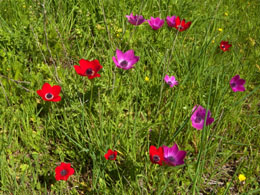A genus of flowering plants belonging to the 'Ranunculaceae' family, 'Anemone' are often seen as garden plants. The following Buzzle article tells you more.

Around 120 species are grouped under this genus. The word
anemone is derived from
anemos (wind) with the meaning of the entire word 'anemone' being the 'daughter of wind'. Thriving well in temperate regions, growing this plant is not very difficult as it requires lesser maintenance than other flowering plants.
The anemone plant grows 1-3 feet in height. Expanse of the branches and leaves also is 1-3 feet. Depending on the variety of plant, different colored flowers can be observed. The colors commonly observed are pink and white.
Flowers
The flowers are delicate and borne on slender stems. The name of 'windflower' assigned to them is because of their positioning on these stems. The blooming season varies with species. Flowers are produced in an inflorescence pattern called cyme, in a single cluster range from 2-9. The flowers have 4-27 sepals, are bisexual in nature and produce 10-200 stamens. The pistils have one ovule each.
Plant Care
This plant grows well in hardiness zones from 4-8, in both partial and bright sunlight. Loamy soil being best-suited for their growth, adding plenty of organic matter to this kind of soil is recommended. It is advisable to dig the soil below the level at which tubers are planted. Planting is carried out in October, and the flowering usually takes place in May and June.
Anemone hupehensis is one of the best autumn flowering species; light soil is suitable for growing this plant. This plant grows to a height of 60-100 cm, and the blooming season lasts for many weeks. The
Anemone coronaria is suitable for growing in summer season. This tuberous-rooted plant produces flowers with stalks that are 15-20 cm in length. This plant is known for its poppy-like flowers, and is thus, also referred to as poppy anemone.






 Around 120 species are grouped under this genus. The word anemone is derived from anemos (wind) with the meaning of the entire word 'anemone' being the 'daughter of wind'. Thriving well in temperate regions, growing this plant is not very difficult as it requires lesser maintenance than other flowering plants.
Around 120 species are grouped under this genus. The word anemone is derived from anemos (wind) with the meaning of the entire word 'anemone' being the 'daughter of wind'. Thriving well in temperate regions, growing this plant is not very difficult as it requires lesser maintenance than other flowering plants.